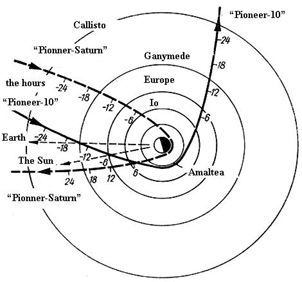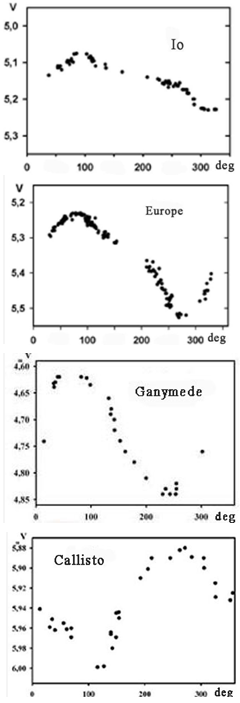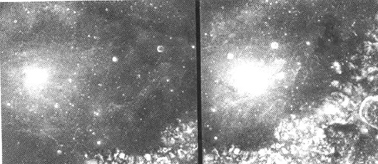-
Paper Information
- Previous Paper
- Paper Submission
-
Journal Information
- About This Journal
- Editorial Board
- Current Issue
- Archive
- Author Guidelines
- Contact Us
International Journal of Astronomy
2012; 1(3): 49-54
doi: 10.5923/j.astronomy.20120103.03
On the Cause of the Discrepancy Between Groundbased and Spaceborne Lightcurves of Galilean Satellites of the Jupiter
V. V. Prokofjeva-Mikhailovskaya , E. A. Sergeeva
Research Institute, “Crimean Astrophysical Observatory”, Nauchny, Crimea, 98408, Ukraine
Correspondence to: E. A. Sergeeva , Research Institute, “Crimean Astrophysical Observatory”, Nauchny, Crimea, 98408, Ukraine.
| Email: |  |
Copyright © 2012 Scientific & Academic Publishing. All Rights Reserved.
Photometric observations of Jupiter's satellites were performed in the spectral band V in Scientific Research Institute “CrAO”. Their light curves were calculated to the phase angle of the Sun equal 6o. Comparison of data with other Earth observations showed good agreement. The cause of discrepancies with the data obtained with the spacecraft is the backscattering effect of sunlight, it depends on the Sun phase angle. The satellite Callisto has leading dark hemisphere due to the fact that at this distance the magnetic field of Jupiter diminished, and bodies of the interplanetary medium bomb out it.
Keywords: Photometric Observations, Jupiter's Satellites, Spacecraft Observations
Article Outline
1. Introduction
- A feature of modern studies solar system is the abundance of new data obtained by the spacecraft. There is a situation where the data received from space is the more reliable. Galileo Galliley at first used the telescope and at January 7, 1610 he discovered four satellites of Jupiter - Io, Europe, Ganymede, Callisto. Currently, these satellites are well studied in different ways. The satellites have the weak atmospheres so they named the atmosphere-free bodies. It is known that the Galilean satellites are always oriented to Jupiter by one side. They are synchronous: the period of rotation around the axis equal to the period of revolution around Jupiter. The surface of satellites have the leading and the driven hemispheres and they have different reflectivity under the influence of space weather and the bombardment by small bodies of the solar system. The Data on the surfaces of the atmosphere-free bodies of the solar system, we get by the exploring the scattered sunlight. Sunlight scattering laws are applicable to studies of the Galilean moons of Jupiter. Galilean satellites are located at the distance about 5 a.u. from the Sun, so it can be assumed that the sun rays fall on them, a parallel beam. In this case the coherent backscattering effect can be well- observe. The satellites Io, Europe and Ganymede are in orbital resonance - their orbital periods are related as 1:2:4. At the time, as Ganymede makes one revolution around Jupiter, Europe makes two and Io four. The theoretical prediction of the of the tidal nature of the volcanism on Io has found a real confirmation. Io's orbit is located in a part of magnetosphere of Jupiter where the streams of charged particles is particularly dense. The magnetosphere rotates with Jupiter with a period about 10 hours.It sweeps away from the surface of Io is about 1000 kg of material per second. Due to the rapid rotation of Jupiter's magnetic field, charged particles along the orbit of Io creates a plasma torus. The temperature in the torus is estimated as 50000-100000 K. The material of the torus is rotating at a speed almost equal to the velocity of Jupiter's magnetosphere, so the particles in it move much faster than Io. Their relative speed reaches 57 km/sec, which causes an intense bombardment of the rear surface of the satellite. Io interacts with the magnetosphere of Jupiter and the torus, forming a powerful electrical generator that generates 400,000 volts voltage and generating an electrical current of about 5 million amperes that flows along magnetic field lines to the ionosphere of Jupiter.
2. Space Research of Galilean Satellites of Jupiter
- For the first time a spacecraft "Pioneer 10" flew past Jupiter on the 4 of December 1973 and transmitted to Earth the images and measurements of various physical fields of Jupiter. One year later on the 2 of Decamber1974 spacecraft "Pioneer 11" was at even closer distance to the planet, carried out detailed measurements and deployed by powerful gravitational field of Jupiter, Saturn went away.
3. The Ground-Based Photometric Study of the Galilean Satellites and the Effect of the Sun Phase Angle
- We present some results of observations of the Galilean satellites of Jupiter from the Earth. In the eighties of the last century, photometric observations of the Galilean satellites were carried out in Uzbekistan on a mountain Maidanak with the 60 cm telescope[7],[8]. Dependence were identified depending on the reflectivity of the satellite orbital phase angle at phase angles of 0o and 6o Sun. The data showed a strong difference between the curves obtained for Callisto with sun phase angle 0o and 6o. The authors explained this difference with the large value of the opposition effect for darker leading hemisphere of Callisto. They concluded that the orbital curves of Galilean satellites depend on the phase angle of the sun and may have different shapes at different phases of the Sun light.
4. Features of the Solar Light Scattered with Atmosphere-Free Bodies of the Solar System
- All atmosphere-free small solar system bodies are covered with regolith. An analysis of lunar soil brought from the Sea of Fertility spacecraft "Luna-16"[25],[13] showed that the soil sample is a fine regolith fractions ranging in size from microns to millimeters. Its density is low and is 1.2 g/cm3, and the average particle size increases with depth from 62 to 114 microns. The amount of glass in the soil increases with decreasing particle size. It is concluded that the formation of fine particles of soil due to the energetic bombardment of the lunar surface. Melting of the particles is the takes place result of high-speed impacts of meteoroids. Barabashov and Akimov[4] studied scattering of ground the column and concluded that the indicators are close to observations of the Moon. They concluded that a certain increase in the brightness of the moon at the full moon must be due to the scattering of light on the microrelief, which has a grain size of less than 1 mm.Data on the presence of fine dust on surfaces ofatmosphere-free bodies is confirmed by many photographs taken on board of the spacecraft. For example, it is known that the surface of asteroid 25143 Itokawa is covered with as large stones, and the smallest dust with a strong turnover.Thus, in the broadest physical sense the surfaceatmosphere-free solar system bodies are rough or very rough. The physical properties of light scattered by such surfaces have been actively studied both theoretically and in laboratories over the last two decades. Dedicated to the review of these issues, V.L Kuzmin and V.P. Romanov demonstrate the rapid and successful development of new experimental and theoretical physics[14]. A special chapter is devoted to the description of light scattering by very rough surfaces, which are the same surfaces of small solar system bodies.The coherent backscattering effect was predicted earlier in 69-73 years of the last century, although astronomers have previously known about changes in the observed brightness of the disk body[1]. Studies of the effect were carried out almost simultaneously in Seattle, Amsterdam and Grenoble, and then in many physics laboratories around the world. The opposition effect of increasing the brightness of atmosphere-free bodies was explained after the discovery and study of the coherent backscattering in disordered systems of particles[14],[15],[5],[6]. The phenomenon was universal, since it is associated with the most common features of light scattering porous media.The phenomenon of the coherent backscattering is the sharp increase in the intensity of light scattered by a strongly inhomogeneous medium in a small solid angle in the direction opposite to the direction of incidence of light. It was found that to each wave, bypassing a number of scattereres corresponds the wave going around the same number of scatterers in the opposite direction. Such waves are coherent. It has been shown that the interference occurs only in the case of dispersion backword, as in this case, the optical paths of waves and the phase shift will be strictly identical. On the basis of studies of the lunar soil it can be concluded that the upper layer of regolith is porous and fine-structured, and on the surfaces of atmosphere-free bodies it is distributed changing unevenly: not only the thickness and density, and particle size distribution. As a result of earthquakes occurring in collisions of bodies, small fraction of the regolith can be moved into the lower room, which leads to the formation of spots on the body surface, which can be detected in observations from the ground surface of the body of scattered solar radiation. These spots formed by the inverse coherent scattering, can only be observed at small Sun phase angles .The coherent backscattering effect of light in the last two decades is studied theoretically and experimentally. It is shown that the effect occurs when the size of scattering particles with dimensions comparable to the wavelength of incident light and the surface of the body has a powder structure, which takes place on small solar system bodies.After the discovery of the coherent backscattering effect of light publications that explain the opposition effect of increasing the brightness of a atmosphereless solar system bodies with the help of this effect[11],[16],[17]) quickly appeared. J.G. Shkuratov[24], with an analysis of photometric data, concluded that the opposition effect of brightness (OEYA) is characteristic for nearly all solid surfaces of celestial bodies, and the amplitude of the effect of a light-body (E-type asteroids and icy satellites of planets) is higher than that dark. Very light surface gives a narrow opposition surge in brightness with an amplitude of up the brightness to increase of up to 2 times. In subsequent years the brightness of opposition effect of many solar system atmosphere-free bodies are actively researches, and it was developed a model of coherent amplification ofbackscattering intensity of light (Figure 3).
5. Comparison of Ground-Based Photometry and Data Made from the Board Spaceships
- In 2006, the SAI under the direction of N. Emelyanov the comparison of the light curves of the Galilean moons of Jupiter, depending on the angle of rotation [20], derived from satellite mapping spacecraft that indicated in Fig. 4 with solid lines, and ground-based photometry, as indicated by dotted lines is made. The discrepancy of comparable results was found[21], which was not found any explanation. Because of these differences at the Research Institute "Crimean Astrophysical Observatory," the task of photometric studies of the Galilean satellites of Jupiter was set.We will recall that to construct maps of Jupiter's satellites images taken by spacecraft at different phase angles and in different spectral regions have been used. For this purpose special program allowing images taken in different lighting conditions of the satellite were used. For example, the photometric properties of the satellite Europe were obtained by analysis of 90 images obtained with spacecraft "Voyager" at phase angles of 3o 143o- satellite in the spectral range from 0.34 to 0.58μ.
6. The Reason for these Discrepancies Photometry and Ground-Based Data of the Spacecraft
7. Conclusions
- The brightness distribution across the disk of the satellite may vary depending on the phase angle of the sun. The discrepancy between the course of the light curves obtained by the spacecraft (SC) and photometry carried out from Earth, because the satellites were photographed from a spacecraft in a wide range of phase angles of illumination of the Sun and from Earth observations are only in the range of phase angles from 0o to 12o. Ie, observations from space vehicles, in most cases, do not take into account the opposition effect. The surfaces of Ganymede and Callisto are covered with regolith, which provides the inverse coherent scattering of sunlight and the greatest difference between the curves of the surface obtained by the spacecraft.It is now known that light scattering bodies of the solar system must take into account the scattering characteristics of the regolith that covers the surface. The upper layer of regolith is composed of small particles that are comparable with the wavelength, and has a large porosity. These properties provide the inverse coherent scattering, discovered and studied in laboratories in the 80s of last century. We must also consider the near-field effect, which manifests itself in more dense environments. He is now being actively studied and used.The discovery and study the laws of light scattering - the opposite coherent scattering and near-field effect - can, in large part, to change the brightness distribution across the disk of Jupiter's moon, depending on the phase angle of the sun. No wonder, N.V. Emelyanov[9],[10] gives importance, pointing to the need for the effects of variations in the surface properties of Reflective satellites. Exactness of determination of coordinates at calculation of the mutual phenomena of Jupiter’s satellites in tens times worse, than expected. Note that the satellites are in a strong magnetic field of Jupiter and Saturn, have a brighter leading hemisphere. It is known that the moons Callisto and Iapetus, which are far away from these planets are darker leading hemisphere, which can be attributed to the bombardment of interplanetary dust, asteroids and comets.To process the photometry of mutual events of Galilean satellites recommend using the latest achievements of physics and astrophysics of light scattering is strongly rough surface (regolith). In processing the mutual phenomena of Jupiter's satellites is desirable to use the light curves of satellites, received at the same solar phase angles at which these observations were made
 Abstract
Abstract Reference
Reference Full-Text PDF
Full-Text PDF Full-Text HTML
Full-Text HTML


